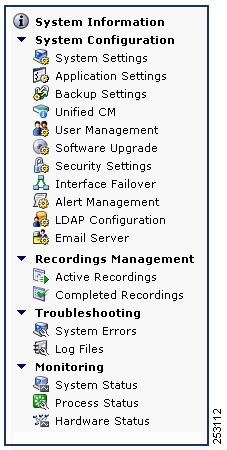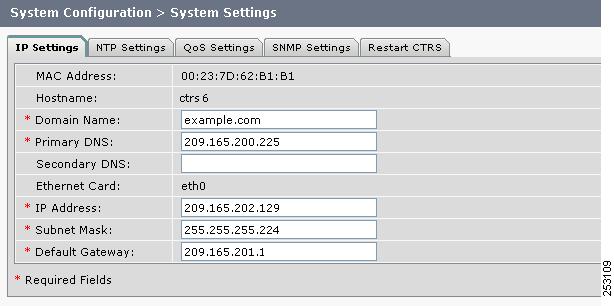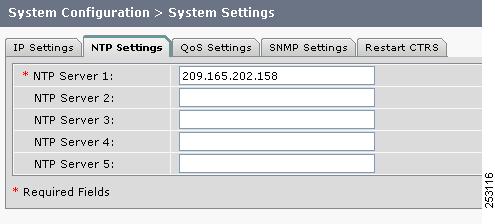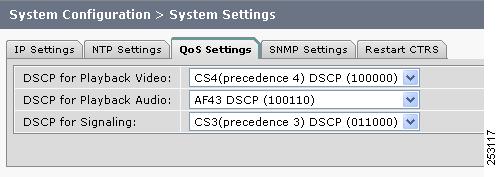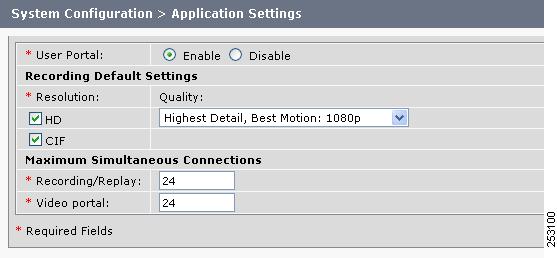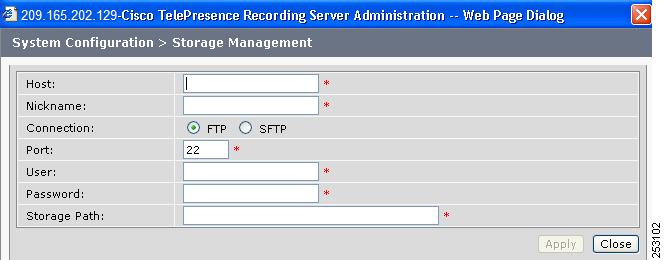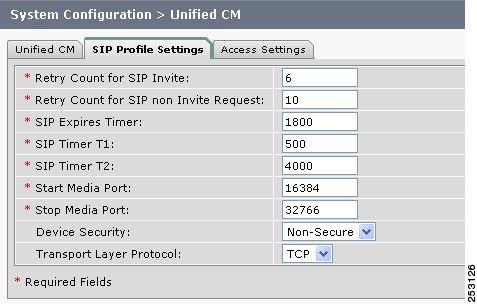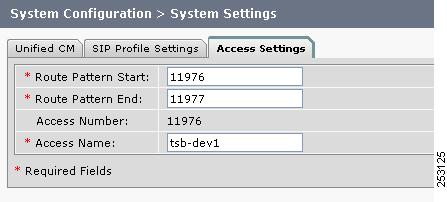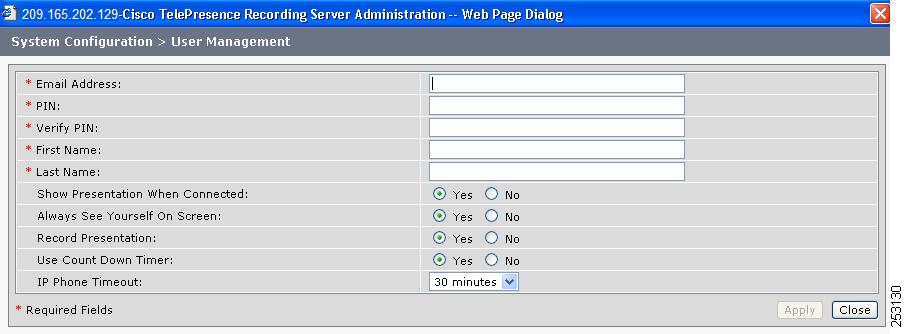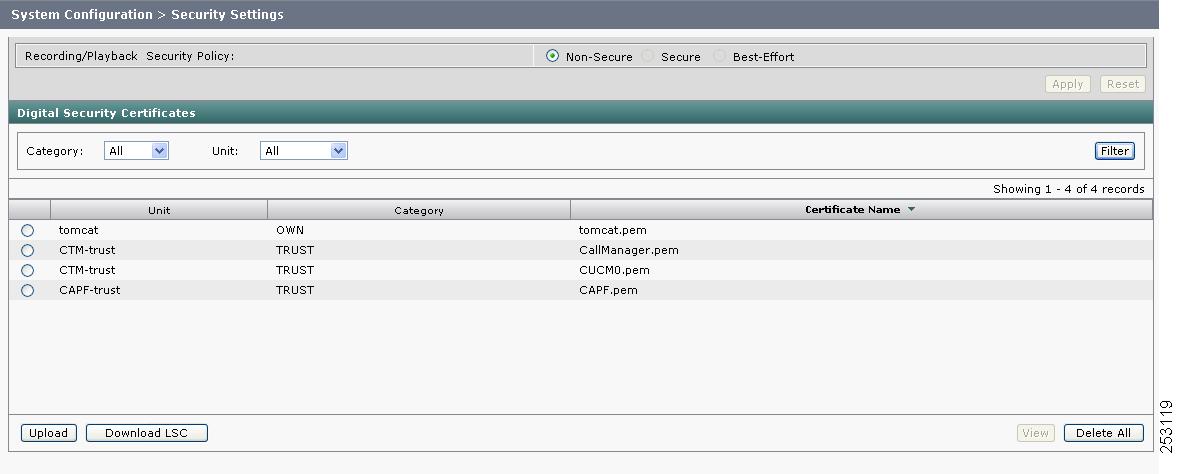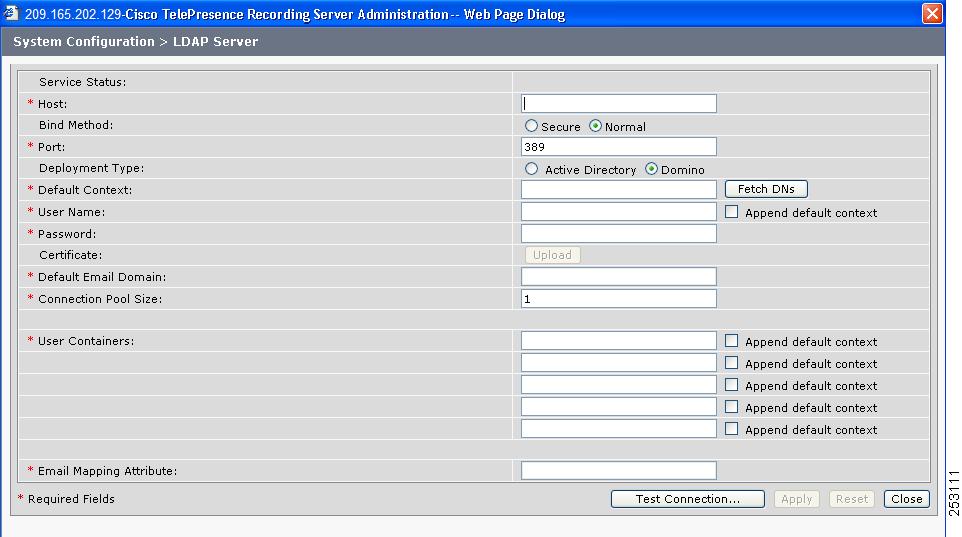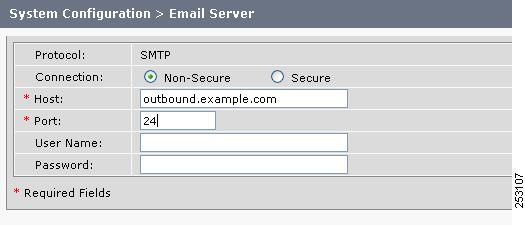

Table Of Contents
Configuring CTRS Administration Software
Logging in to the Administrative User Interface
Left Menu of the Administrative User Interface
Creating a New User or Modifying Settings for an Existing User
Configuring Multiple Domains in an LDAP Forest
Configuring CTRS Administration Software
Revised: November 2009The following sections describe settings in the System Configuration screens for the Cisco TelePresence Recording Server (CTRS). System Configuration is divided into the following areas:
•
Logging in to the Administrative User Interface
•
Left Menu of the Administrative User Interface
Logging in to the Administrative User Interface
To log in to the CTRS administrative user interface, do the following:
Step 1
Open an IE 6.x or 7.x browser.
Step 2
In the address bar, enter https://CTRS_URL/admin.
Note
You must add /admin to the CTRS URL to get to the administrative user interface. If you enter the CTRS URL without appending /admin, you go to the CTRS user portal.
Step 3
Enter your username and password.
For more information about the initial installation of CTRS, including setting the administrator username and password for the first time, see Chapter 3, "Installing CTRS Administration Software."
System Information
Click System Information in the left menu to view information about the CTRS. The information displayed under System Information is configured during CTRS software installation.
•
SKU
•
Hostname: Hostname of the CTRS.
•
IP Address and subnet mask: IP address and corresponding subnet mask of the Cisco TelePresence Recording Server.
•
MAC Address: MAC address of the Cisco MCS 7800 Series Media Convergence Server on which the Cisco TelePresence Recording Server is running
•
Hardware Model: Model number of the Cisco MCS 7800 Series Media Convergence Server on which the Cisco TelePresence Recording server is running.
•
Software Version: Version of CTRS Administration software currently installed.
•
Operating System (OS) Version
•
Kernel Version
Left Menu of the Administrative User Interface
You can access any of the System Configuration screens from the left menu in the CTRS user interface (see Figure 4-1):
Figure 4-1 System Configuration—Left Menu
System Settings
System Settings are initially configured during CTRS Administration software set up. Use the System Settings to make changes to these initial settings. System Settings consists of the following configuration areas:
IP Settings
In System Settings, click the IP Settings tab to display or configure IP settings (see Figure 4-2).
Figure 4-2 System Configuration > System Settings—IP Settings
Some of the settings displayed on the IP Settings screen are configured during initial installation of the CTRS administration software. The following fields are configurable on this screen:
•
Domain Name
•
Primary DNS
•
Secondary DNS
•
IP Address
•
Subnet Mark
•
Default Gateway
•
To register new or modified settings, click Apply.
•
To restore the original settings, click Reset.
NTP Settings
In System Settings, click the NTP Settings tab to display or configure Network Time Protocol (NTP) servers (see Figure 4-3).
Figure 4-3 System Configuration > System Settings—NTP Settings
NTP is used to synchronize the clocks on Cisco IP telephony servers with an external network time server that uses NTP.
Click the NTP Setting tab in the System Settings window to list the configured IP address of the NTP servers.
•
To register new or modified settings, click Apply.
•
To restore the original settings, click Reset.
QoS Settings
In System Settings, click the QoS Settings tab to display or configure quality of service (QoS) settings (see Figure 4-4).
Figure 4-4 System Configuration > System Settings—QoS Settings
QoS values define the traffic marking values used for network queuing for CTRS. Enter or edit settings as described in Table 4-3.
•
To register new or modified settings, click Submit.
•
To restore the original settings, click Reset.
SNMP Settings
In System Settings, click the SNMP Settings tab to display or configure Simple Network Management Protocol (SNMP) settings (see Figure 4-5).
Figure 4-5 System Configuration > System Settings—SNMP Settings
The Simple Network Management Protocol (SNMP) is an application layer protocol that facilitates the exchange of management information between network devices. It enables network administrators to manage network performance, find and solve network problems, and plan for network growth by analyzing information gathered using MIBs. You configure all SNMP settings through the CTRS command line interface (CLI) commands.
SNMP is enabled by default, and it monitors the CTRS system status (go to Monitoring > System Status for system status details). You can designate a particular server where SNMP trap messages are gathered and stored. Configuration requires username and password authentication.
By default, SNMP service is enabled. The following default SNMP settings are also enabled:
•
SNMPv3 username set to "mrtg." This name is for internal use of the system and should not be deleted.
•
SNMPv2c username set to "public." This name is for internal use of the system and should not be deleted.
•
No trap receiver is configured. Use CTRS CLI commands to configure SNMP trap receiver information.
Table 4-4 describes the SNMP fields. All fields in this screen are view-only.
Restart or Shutdown CTRS
In System Settings, click the Restart CTRS tab to restart or to shut down the CTRS (see Figure 4-6).
Figure 4-6 System Configuration > System Settings—Restart CTRS
To restart CTRS:
Step 1
Click System Settings in the left menu.
Step 2
Click the Restart CTRS tab.
Step 3
Click Restart to restart CTRS. Restart means that the CTRS shuts down and then reboots.
To shutdown CTRS:
Step 1
Click System Settings in the left menu.
Step 2
Click the Restart CTRS tab.
Step 3
Click Shutdown to shut down CTRS.
Application Settings
Click Application Settings in the left menu to display or modify application settings (see Figure 4-7).
Figure 4-7 System Configuration > Application Settings
Application Settings allow you to define general CTRS recording settings (see Table 4-5).
•
To register new or modified settings, click Apply.
•
To restore the original settings, click Reset.
Backup Settings
Backup Settings consist of the following tabs:
Archive Servers
In Backup Settings, click the Archive Servers tab to display or configure archive servers (see Figure 4-8).
Figure 4-8 System Configuration > Backup Settings—Archive Servers
The Archive Servers screen displays a table providing the following information about previously defined archive servers:
•
To display a defined number of table rows, click the down arrow next to Rows per page. Highlight and choose predetermined amounts.
•
If the number of entries exceeds the Rows per Page value, click First to view the entries listed on the first page, Next to view the next page in sequence, Previous to view the preceding page, and Last to view the last page.
•
To delete one of the defined archive servers, check the box to the left of the table entry, and then click Delete.
•
To test whether your defined FTP or SFTP username, password and path are valid, check the box to the left of the table entry and then click Test Connection. If the connection is valid, CTRS displays a text box stating that the connection is valid. If the connection is not valid, CTRS displays a text box describing what part of the connection process failed.
•
To edit one of the defined archive servers, check the box to the left of the table entry. Then click Edit. A dialog box appears (see Figure 4-9).
•
To define a new server, click New. A dialog box appears (see Figure 4-9).
Figure 4-9 System Configuration > Backup Settings—Archive Servers (New or Edit)
When you click Edit or New, CTRS administration software takes you to the Storage Management screen, as described in Table 4-7. Use this screen to edit existing archive server settings or to define new archive servers.
•
To register new or modified settings, click Apply.
•
To close this window and return to the Archive Servers list, click Close.
System Backup and Restore
In Backup Settings, click the System Backup/Restore tab to display or configure settings for backup or system restoration (see Figure 4-10). From this screen, you can also perform a system backup or restoration.
Figure 4-10 System Configuration > Backup Settings—System Backup/Restore
The System Backup and Restore window is divided into two sections:
•
Backup Database and Configuration Files (top part of the window)
•
Restore Database and Configuration Files (bottom part of the window)
To schedule a system backup:
Step 1
To define the time scheduled for the automatic backup, click Change. From the Change window, enter information for the following fields:
a.
Start Time: Choose the hour and minute (U.S. Pacific time zone, twenty-four hour format) from the drop-down menu for the scheduled backup.
b.
Frequency: Resend every: Defines the frequency of the backup. Click the appropriate radio button to choose Daily or Weekly backups; if you click Weekly, also choose the days of the week on which you want the backup to occur.
c.
Click OK to apply your changes.
Step 2
Choose the content to be backed up from the Backup drop-down list.
Step 3
Choose the archive server where the data will be stored from the To drop-down list.
Step 4
Click Save Schedule. The contents of the CTRS database will be sent to the indicated server on the defined day(s) at the scheduled time.
Note
The CTRS saves only the current system backup settings. The CTRS does not save previous backup settings.
To perform an immediate system backup:
•
Click Backup Now. The CTRS content is sent to the indicated archive server.
Backup database fields are described in Table 4-8.
To restore the CTRS database:
Step 1
Choose the CTRS database content that you want to restore from the Restore drop-down menu.
Step 2
Choose the archive server (where the content you want to restore is saved) from the From drop-down menu. If you need to add a new archive server to the list, click Add Server. CTRS takes you to the Archive Server: Storage Management window to add a new server.
Step 3
After you have chosen the appropriate archive server, click Show to display the databases available to be used to restore the CTRS database.
•
To display a defined number of table rows, click the down arrow next to Rows per page. Click to highlight and choose predetermined amounts.
•
If the number of files exceeds the Rows per Page value, click First to view the files listed on the first page, Next to view the next page in sequence, Previous to view the preceding page, and Last to view the last page.
Step 4
Click the radio button to the left of the appropriate database file.
Step 5
Click Restore Now. CTRS content is retrieved from the indicated archive server and loaded on the CTRS.
Restore task fields are described in Table 4-9.
Export Media Files
In Backup Settings, click the Export Media Files tab to display or configure settings to export media files (see Figure 4-11).
Figure 4-11 System Configuration > Backup Settings—Export Media Files
Use the Export Media Files screen to configure when CTRS transfers CTRS media data to a specified archive server. Export Media Files fields are described in Table 4-10.
•
To register new or modified settings, click Submit.
•
To reset to default values, click Reset.
For example, in the Schedule field, you click the Change button. For Start Time, you choose 23:45, and for Frequency, you choose Daily. In the Media is older than field, you enter 60. As the Action to be taken daily at 23:45, you check the Export box and specify a server to which the CTRS will export videos that are older than 60 days. You also check Delete, and in the Notify video owner field, you enter 10.
With this configuration, daily at 23:45, CTRS exports each video that is older than 60 days to the specified server. CTRS also marks for deletion each video that it exported. For the next ten days, CTRS marks the status of the video as "Delete Pending" (CTRS displays the status of each video in the list in Recordings Management > Completed Recordings). CTRS also sends an e-mail notification to the video owner to alert the owner of the upcoming deletion. This notification is sent every day for ten days. At the end of the ten-day period, the video is deleted from CTRS.
Import Media Files
In Backup Settings, click the Import Media Files tab to display or configure settings to import media files (see Figure 4-12).
Figure 4-12 System Configuration > Backup Settings—Import Media Files
The Import Media Files screen lets you choose data files from a list of defined archive servers to be imported into the CTRS database.
To import media files:
Step 1
Click the down arrow to the right of Import From to display the list of available archive servers; highlight to select.
Step 2
After you have selected the appropriate archive server, click Show to display the files available to be imported.
•
To display a defined number of table rows, click the down arrow next to Rows per page. Click to highlight and select predetermined amounts.
•
If the number of files exceeds the Rows per Page value, click First to view the files listed on the first page, Next to view the next page in sequence, Previous to view the preceding page, and Last to view the last page.
•
To refresh the list of files displayed, click Refresh.
Step 3
Check the box to the left of the file to choose it. To choose all files listed, check the box in the upper left of the table.
Step 4
Click Import Files.
Unified CM Settings
Cisco Unified Communications Manager Settings (Cisco Unified CM) consists of two configuration areas:
Cisco Unified CM Settings
In Unified CM, click the Unified CM tab to display or configure Cisco Unified CM servers and SIP ports (see Figure 4-13).
Figure 4-13 System Configuration > Unified CM—Unified CM
From the Unified CM tab, you can specify Cisco Unified Communications Manager servers and SIP ports (see Table 4-11).
•
To register new or modified settings, click Apply.
•
To restore the original settings, click Reset.
SIP Profile Settings
In Unified CM, click the SIP Profile Settings tab to display or configure SIP profile settings (see Figure 4-14).
Figure 4-14 System Configuration > Unified CM—SIP Profile Settings
SIP profile settings, which are described in Table 4-12, are applied to all SIP ports that you specify in the Unified CM tab.
•
To register new or modified settings, click Apply.
•
To restore the original settings, click Reset.
Access Settings
In Unified CM, click the Access Settings tab to display or configure route patterns or access settings (see Figure 4-15).
Figure 4-15 System Configuration > Unified CM—Access Settings
All of the settings on the Access Settings screen are derived from settings you configured in Cisco Unified Communications Manager (Cisco Unified CM).
•
To register new or modified settings, click Apply.
•
To restore the original settings, click Reset.
User Management
Use the fields under User Management to define CTRS administrators and to provide access to the user portal. User Management is divided into two tabs:
Administrative Portal
In User Management, click the Administrative Portal tab to display or configure CTRS administrative roles (see Figure 4-16).
Figure 4-16 System Configuration > User Management—Administrative Portal
Access to task menus within CTRS Administrative software is dependent on defined administrative roles. CTRS administration software recognizes three different administrative roles:
•
Administrator: Administrators have the authority to perform all tasks associated with configuring, administering, monitoring and troubleshooting CTRS.
•
Content Manager: Content Managers primarily are responsible for managing activities associated with recording. They can only access CTRS Recording Management and System Status windows.
•
Diagnostic Technician: Diagnostic Technicians have the authority to perform CTRS monitoring and troubleshooting tasks. They can only access CTRS Troubleshooting and Monitoring windows.
Administrative Portal initially displays a table providing the following information about already-defined administrative users as described in Table 4-14:
•
To display a defined number of table rows, click the down arrow next to Rows per page. Highlight and select predetermined amounts.
•
If the number of entries exceeds the Rows per Page value, click First to view the entries listed on the first page, Next to view the next page in sequence, Previous to view the preceding page, and Last to view the last page.
•
To delete one of the defined administrators, click the radio button to the left of the table entry, and then click Delete.
•
To define a new administrator, click New.
•
To edit one of the defined administrators, click the radio button to the left of the table entry, and then click Edit.
Creating a New Administrative User
When you click New, a dialog box appears (see Figure 4-17).
Figure 4-17 System Configuration > User Management—Administrative Portal (New)
Enter settings as described in Table 4-15.
•
To register new or modified settings, click Apply.
•
To close the window, click Close.
Note
When you add a new administrative user, the CTRS does not validate that administrative user against LDAP. When you add a user, the CTRS ensures that the user exists in LDAP.
Editing a Defined Administrative User
When you click the radio button for a particular administrative user and then click Edit, a dialog box appears. Enter settings as described in Table 4-16.
•
To register new or modified settings, click Save.
•
To close the window, click Close.
End-User Portal
Note
You should configure LDAP servers before you create users for the user portal. To configure LDAP servers, go to System Configuration > LDAP Configuration.
In User Management, click the End-user Portal tab to display or configure users of the user portal (see Figure 4-18).
Figure 4-18 System Configuration > User Management—End-user Portal
When you click the End-user Portal tab, you see a list of users with access to the CTRS user portal on an IP phone or through a web browser. Through the IP phone or the web browser, users can edit, view, and share videos. From the IP phone, users can also record videos.
•
To specify the number of user entries that are displayed on the page, click the down arrow next to Rows per page. Click a number to display more or fewer entries.
•
If the number of entries exceeds the Rows per page value, click First to view the entries listed on the first page, Next to view the next page in sequence, Previous to view the preceding page, and Last to view the last page.
•
To delete a user, click the radio button next to the user email address. Then click Delete. All recordings that belong to this user are deleted from the CTRS.
•
To edit the settings for a user, click the radio button next to the user email address. Then click Edit. After you modify settings, click Save.
•
To create a new user, click New.
Creating a New User or Modifying Settings for an Existing User
When you click New or Edit, a dialog box appears (see Figure 4-19).
Figure 4-19 System Configuration > User Management—End-user Portal (New or Edit)
Enter settings as described in Table 4-17.
•
To save the settings for a new user, click Apply. To save settings for an existing user, click Save.
•
To close the dialog box without saving the settings, click Close.
Note
The CTRS administrator does not have to create user accounts and PINs. Users can create their own accounts and PINs to access the browser-based user portal. When users create accounts, they automatically appear in the user list in the End-user Portal tab in the CTRS administrative UI (see Figure 4-18).
To learn how to create their own accounts, users should read the "Creating and Viewing Recordings with the Cisco TelePresence Recording Server" chapter in the Cisco TelePresence System User Guide:
http://www.cisco.com/en/US/docs/telepresence/cts_admin/1_6/userguide/cts1_6_ug.html
Software Upgrade
Click Software Upgrade in the left menu to display, switch, or upgrade software versions (see Figure 4-20).
Figure 4-20 System Configuration > Software Upgrade
There are two functions to assist you in maintaining the system software, as follows:
•
Switch Version: The hard drive on the server on which CTRS is installed is partitioned into two areas. Each area can contain a system image. Switch Version allows you to switch the location of two stored versions of the system software.
•
Upgrade Software: CTRS provides a patch file for upgrading system software. The Cisco-supplied patch file can be stored on a CD-ROM or a Secure FTP (SFTP) host network. A wizard displays dialog boxes to prompt you through the process.
To switch software versions:
•
Click the Switch Version button.
The system will swap the software versions and reboot. Screens will describe activity.
The active partition in the server hard drive contains the active system image. The software versions that are loaded will be displayed in the Active Version and Inactive Version fields.
To upgrade software:
Step 1
To start the software upgrade process, click the Upgrade Software button.
The Source Selection dialog box appears.
If you need to stop the software installation, click the Cancel button when the button is active.
Step 2
Click the CD-ROM or Network radio button to choose the location of the patch file.
If you chose CD-ROM, click Next to go to the File Selection window.
If you chose Network, provide the hostname, login username, password, and the path to the patch file. By default, port 22 is used to access the server; supply the correct port number, if required. Click Next to go to the File Selection window.
Step 3
At the File Selection window, choose the file to load by clicking its radio button. Then click Next.
Step 4
The Patch File Preparation window appears. Watch this window to monitor the progress of the file download. Buttons will be inactive until the patch file is loaded.
Once the file is loaded, the window displays a Confirmation message.
The software wizard displays the software versions that are installed and provides radio buttons so you can choose to switch the newly loaded software to the active partition.
Step 5
Click Yes or No to make your choice. Then click Next to finish the software upgrade task.
The install wizard displays a dialog window that logs the progress of the update.
Step 6
When the log indicates that the files have been switched, click Finish to complete this task.
Security Settings
CTRS supports secure communication between Cisco TelePresence devices using Certificate Authority Proxy Function (CAPF). Each Cisco TelePresence product downloads a Locally Significant Certificate (LSC) from a CAPF server; communication between devices is then authenticated using LSCs, Cisco Unified Communications Manager (Unified CM) Root Certificates and a CAPF Root Certificate.
To configure CTRS for security, you need to first complete preliminary steps in Unified CM. You must activate and start CAPF service, create application users, create Unified CM root certificates for every Unified CM server associated with Cisco TelePresence service, and create a CAPF root certificate. Then from the Security Settings window in CTRS, you upload the applicable Unified CM and CAPF root certificates, and download the appropriate LSCs. When all certificates are in place and the LSC is downloaded, the CTRS reboots so that the security settings to take effect.
To configure CAPF Security for CTRS:
Step 1
From Cisco Unified CM: Configure Cisco Unified CM to run in secured mode. For more information, refer to Cisco Unified Communications Manager Installation Guide for the Cisco TelePresence System Release 1.6.
Step 2
From Cisco Unified CM: Create an application user in Cisco Unified CM. From the Cisco Unified CM Administration page, click Application User from the User Management drop-down menu. Click Add New and then complete all necessary Application User Information fields. Be sure that the user is included in the "Standard CTI Enabled" group, and the "Standard CTI Secure" group and the "Standard CTS Secured Connection" role under Permission Information. When finished, click Save.
Note
Create an application user for each Cisco TelePresence product (such as CTS, CTMS, CTRS and CTS-Man) in your network.
Step 3
From Cisco Unified CM: Create an Application User CAPF profile in Cisco Unified CM. From the Cisco Unified CM Administration page, Click Application User CAPF Profile from the User Management drop-down menu. Click Add New. Choose the application user you previously created from the Application User drop-down list and then complete the appropriate CAPF profile fields for that user:
•
Instance ID: Unique identifier (alpha-numeric) for the cluster
•
Certificate Operation: Choose "Install/Upgrade."
Note
Certificate Operation resets automatically to "No Pending Operation" after a certificate is downloaded. You must reset this field to "Install/Upgrade" for additional certificate downloads.
•
Authorization String: Click "Generate String" to get a one-time authorization code to download certificates
•
Key size: Default value is 1024.
When finished, click Save.
Note
Create an Application User CAPF Profile for each CTRS in your network.
Step 4
From Cisco Unified CM: Configure SIP Trunk Security in Cisco Unified CM. From the Cisco Unified CM Administration page, from the System menu, click Security Profile and then SIP Trunk Security Profile. Click Find to display a list of SIP Trunk Security profiles. Find the appropriate profile and click the hypertext link for that profile. Enter:
•
Name: Unique profile name
•
Description: Identifying description for this profile
•
Device Security Mode: Choose "Encrypted"
•
Incoming Transport Type: TLS
•
Outgoing Transport Type TLS
•
X.509 Subject Name: Enter the subject name of the CTRS Root Certificate
•
Incoming Port: Unique port number
Note
Port 5060 is for the non-secure device security mode.
Click Save if you are revising an existing profile; Click Add New if you are creating a new profile.
Step 5
From Cisco Unified CM: Download CAPF Root Certificate in Cisco Unified CM. From Cisco Unified OS Administration in Cisco Unified CM, Click Certificate Management from the Security drop-down menu. Click Find to display a list of certificates. Find the CAPF Root Certificate (for example, CAPF.der), and select the hypertext link for that certificate. Click Download and then follow the download instructions. Save the CAPF Root Certificate to your desktop with the following name: CAPF.der.
Step 6
From CTRS: Upload the CAPF Root Certificate in CTRS. From the Security Settings window in CTRS (see Figure 4-21), click Upload, then select:
•
Unit: CAPF-Trust
•
Category: TRUST
•
Certificate: Choose the CAPF Root certificate that you downloaded from Cisco Unified CM (CAPF.der).
Click Upload to upload the CAPF Root certificate.
Figure 4-21 System Configuration > Security Settings
Step 7
From Cisco Unified CM: Download Cisco Unified CM Root Certificate in Cisco Unified CM. From Cisco Unified OS Administration in Cisco Unified CM, click Certificate Management from the Security drop-down menu. Click Find to display a list of certificates. Find the Cisco Unified CM Root Certificate (for example, CallManager.der), and select the hypertext link for that certificate. Click Download and follow the download instructions. Save the Cisco Unified CM Root Certificate for the Publisher as CUCM0.der
Note
Names must be in the following format: CUCM#.der, where # is 0 for Publisher and 1 through 6 for Subscribers.
Step 8
From CTRS: Upload the Cisco Unified CM Root Certificate(s) in CTRS. From the Security Settings window in CTRS, Click Upload. Select:
•
Unit: CTM-Trust
•
Category: TRUST
•
Certificate: Choose the Cisco Unified CM root certificate that you created in Cisco Unified CM (CUCM0.der).
Click Upload to upload the Cisco Unified CM root certificate.
Step 9
From CTRS: Download the LSC in CTRS. After creating the application user and application user CAPF profile, from CTRS, click Security Settings to open the Security Settings window. Click Download LSC and fill out the fields:
•
CAPF Instance ID: Must match instance ID created in Cisco Unified CM.
•
CAPF Auth String: Must match authorization string created in Cisco Unified CM.
•
TFTP Server Host: Cisco Unified CM TFTP server.
•
TFTP Server Port: Must be 69, which is the default value.
•
CAPF Server Host: Cisco Unified CM CAPF server host.
•
CAPF Server Port: Must be 3804, which is the default value.
Click Download LSC. After the LSC has been successfully downloaded, the CTRS reboots automatically.
Step 10
From CTRS: Secure CTRS. From the Unified CM window in CTRS, click the SIP Profile Settings tab. For Device Security, click either Encrypted without SDP Keys for 6.1.2 Cisco Unified CM or Encrypted with SDP Keys for 7.0 Cisco Unified CM.
To choose the default security level:
Step 1
From CTRS: After the system reboots, you can choose the default meeting security level. In System Configuration > Security, go to the Recording/Playback Security Policy area (see Figure 4-21).
Step 2
Click Non-Secure, Secure, or Best Effort.
•
Non-Secure means that devices do not have to have valid Locally Significant Certificates (LSCs) from a Certificate Authority Proxy Function (CAPF) server.
•
Secure means that devices must have valid LSCs from a CAPF server.
•
Best Effort means that if a device has an LSC and others do not, the security level is Non-Secure.
Note
To verify device security settings, go to System Configuration > Unified CM and click the SIP Profile Settings tab. If you choose Non-Secure from the Device Security drop-down menu, only Non-Secure is available as the Recording/Playback Security Policy setting.
Step 3
Click Apply.
Interface Failover
Click Interface Failover in the left menu to display or modify failover settings for Ethernet adapters (see Figure 4-22).
Figure 4-22 System Configuration > Interface Failover
When enabled, the secondary adapter handles all network traffic if the primary adapter or its connection fails.
To enable interface failover:
Step 1
Make sure that the primary Ethernet adapter (Ethernet interface 0) is connected to the network and that its static IP address and gateway parameters were correctly configured during system installation.
Step 2
Connect the secondary Ethernet cable (Ethernet interface 1) to a network switch. The connection port can be on the same switch as Ethernet interface 0 or on a different switch, but both Ethernet interface 0 and Ethernet interface 1 must be on the same gateway.
Step 3
From the Interface Failover window, click the Enable button, then click Apply.
Note
If both network interfaces are not available or active, you cannot enable interface failover. If the Enable and Disable radio buttons are dimmed, check the connectivity of the interfaces.
To disable interface failover:
Step 1
With no active meetings in progress, click the Disable button.
Step 2
Click Apply. Your network adapters will be configured and restarted and the interface failover disabled.
Alert Management
Click Alert Management in the left menu to display or configure alert management settings (see Figure 4-23).
Figure 4-23 System Configuration > Alert Management
Use the Alert Management screen to define the CTRS disk threshold at which export data (either transfer to archive servers or data deletion) will be sent to the users and the email addresses to which these alerts will be sent. Enter settings as described in Table 4-18
Note
To see current disk utilization for media storage, go to Monitoring > Hardware Status.
•
To register new or modified settings, click Submit.
•
To restore default settings, click Reset.
LDAP Configuration
Click LDAD Configuration in the left menu to display or modify the Lightweight Directory Access Protocol (LDAP) configuration (see Figure 4-24).
Figure 4-24 System Configuration > LDAP Configuration
Use the LDAP Configuration screen to assign and make changes to designated LDAP servers to be used with CTRS.
When you first open the LDAP Configuration window, CTRS displays a table listing all of the already-defined LDAP servers. LDAP table fields are described in Table 4-19.
•
To display a defined number of table rows, click the down arrow next to Rows per page. Click to highlight and select predetermined amounts.
•
If the number of table entries exceeds the Rows per Page value, click First to view the entries listed on the first page, Next to view the next page in sequence, Previous to view the preceding page, and Last to view the last page.
•
To refresh the list of available LDAP servers, click Refresh.
•
To delete one of the LDAP servers, check the box to the left of the table entry, and then click Delete.
•
To edit one of the definitions for an LDAP server, check the box to the left of the table entry, and then click Edit.
•
To define a new LDAP server, click New.
When you click Edit or New, CTRS administration software takes you to the New LDAP Server configuration screen (see Figure 4-25), as described in Table 4-20. Use this screen to edit existing archive server settings or to define new archive servers.
Figure 4-25 System Configuration > LDAP Configuration (New or Edit)
•
To test the connection between CTRS and the LDAP server, click Test Connection. If the connection is valid, CTRS displays a text box stating that the connection is valid. If the connection is not valid, CTRS displays a text box describing what part of the connection process failed.
•
To register new or modified settings, click Apply.
•
To restore default settings, click Reset.
•
To exit without applying changes, click Close.
Configuring Multiple Domains in an LDAP Forest
To configure multiple domains in an LDAP forest, you must configure all subsequent domains as user containers in the first domain's LDAP configuration page.
For example, you have these two servers:•
LDAP server 1: corporate-cor1
Default context: DC=cor1, DC=com
User container: cn=users, DC=cor1, DC=com
•
LDAP server 2: corporate-cor2
Default context: DC=cor2, DC=com
User container: cn=users, DC=cor2, DC=com
For CTRS, you must configure LDAP server 1 to include LDAP server 2's user containers. In the configuration page for LDAP server 1, in the User Containers fields, you would enter the following, each in its own field:
•
cn=users, DC=cor1, DC=com
•
cn=users, DC=cor2, DC=com
Note
Users in subsequent domains must sign in to the CTRS with their username and domain name—username@example.com
Email Server
Click Email Server in the left menu to display or modify e-mail server settings (see Figure 4-26).
Figure 4-26 System Configuration > Email Server
Use the Email Server screen to define the e-mail server that CTRS uses to send out alerts and video attachments. Fields in the Email Server screen are described in Table 4-21.
•
To register new or modified settings, click Apply.
•
To restore default settings, click Reset.

 Feedback
Feedback
